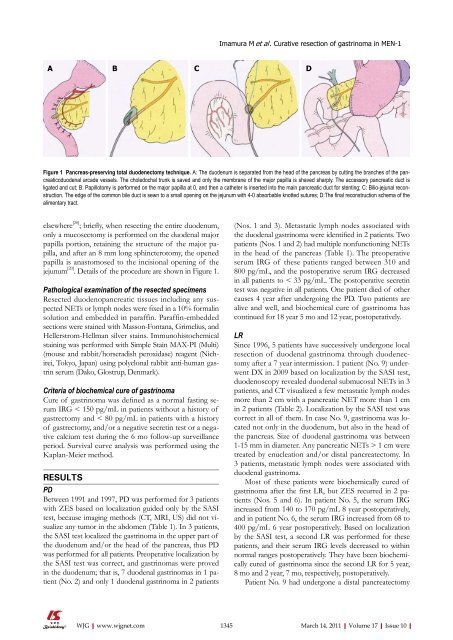10 - World Journal of Gastroenterology
10 - World Journal of Gastroenterology
10 - World Journal of Gastroenterology
Create successful ePaper yourself
Turn your PDF publications into a flip-book with our unique Google optimized e-Paper software.
Imamura M et al . Curative resection <strong>of</strong> gastrinoma in MEN-1<br />
A B C D<br />
Figure 1 Pancreas-preserving total duodenectomy technique. A: The duodenum is separated from the head <strong>of</strong> the pancreas by cutting the branches <strong>of</strong> the pancreaticoduodenal<br />
arcade vessels. The choledochal trunk is saved and only the membrane <strong>of</strong> the major papilla is shaved sharply. The accessory pancreatic duct is<br />
ligated and cut; B: Papillotomy is performed on the major papilla at 0, and then a catheter is inserted into the main pancreatic duct for stenting; C: Bilio-jejunal reconstruction.<br />
The edge <strong>of</strong> the common bile duct is sewn to a small opening on the jejunum with 4-0 absorbable knotted sutures; D:The final reconstruction schema <strong>of</strong> the<br />
alimentary tract.<br />
elsewhere [20] ; briefly, when resecting the entire duodenum,<br />
only a mucosectomy is performed on the duodenal major<br />
papilla portion, retaining the structure <strong>of</strong> the major papilla,<br />
and after an 8 mm long sphincterotomy, the opened<br />
papilla is anastomosed to the incisional opening <strong>of</strong> the<br />
jejunum [20] . Details <strong>of</strong> the procedure are shown in Figure 1.<br />
Pathological examination <strong>of</strong> the resected specimens<br />
Resected duodenopancreatic tissues including any suspected<br />
NETs or lymph nodes were fixed in a <strong>10</strong>% formalin<br />
solution and embedded in paraffin. Paraffin-embedded<br />
sections were stained with Masson-Fontana, Grimelius, and<br />
Hellerstrom-Hellman silver stains. Immunohistochemical<br />
staining was performed with Simple Stain MAX-PI (Multi)<br />
(mouse and rabbit/horseradish peroxidase) reagent (Nichirei,<br />
Tokyo, Japan) using polyclonal rabbit anti-human gastrin<br />
serum (Dako, Glostrup, Denmark).<br />
Criteria <strong>of</strong> biochemical cure <strong>of</strong> gastrinoma<br />
Cure <strong>of</strong> gastrinoma was defined as a normal fasting serum<br />
IRG < 150 pg/mL in patients without a history <strong>of</strong><br />
gastrectomy and < 80 pg/mL in patients with a history<br />
<strong>of</strong> gastrectomy, and/or a negative secretin test or a negative<br />
calcium test during the 6 mo follow-up surveillance<br />
period. Survival curve analysis was performed using the<br />
Kaplan-Meier method.<br />
RESULTS<br />
PD<br />
Between 1991 and 1997, PD was performed for 3 patients<br />
with ZES based on localization guided only by the SASI<br />
test, because imaging methods (CT, MRI, US) did not visualize<br />
any tumor in the abdomen (Table 1). In 3 patients,<br />
the SASI test localized the gastrinoma in the upper part <strong>of</strong><br />
the duodenum and/or the head <strong>of</strong> the pancreas, thus PD<br />
was performed for all patients. Preoperative localization by<br />
the SASI test was correct, and gastrinomas were proved<br />
in the duodenum; that is, 7 duodenal gastrinomas in 1 patient<br />
(No. 2) and only 1 duodenal gastrinoma in 2 patients<br />
(Nos. 1 and 3). Metastatic lymph nodes associated with<br />
the duodenal gastrinoma were identified in 2 patients. Two<br />
patients (Nos. 1 and 2) had multiple nonfunctioning NETs<br />
in the head <strong>of</strong> the pancreas (Table 1). The preoperative<br />
serum IRG <strong>of</strong> these patients ranged between 3<strong>10</strong> and<br />
800 pg/mL, and the postoperative serum IRG decreased<br />
in all patients to < 33 pg/mL. The postoperative secretin<br />
test was negative in all patients. One patient died <strong>of</strong> other<br />
causes 4 year after undergoing the PD. Two patients are<br />
alive and well, and biochemical cure <strong>of</strong> gastrinoma has<br />
continued for 18 year 5 mo and 12 year, postoperatively.<br />
LR<br />
Since 1996, 5 patients have successively undergone local<br />
resection <strong>of</strong> duodenal gastrinoma through duodenectomy<br />
after a 7 year intermission. 1 patient (No. 9) underwent<br />
DX in 2009 based on localization by the SASI test,<br />
duodenoscopy revealed duodenal submucosal NETs in 3<br />
patients, and CT visualized a few metastatic lymph nodes<br />
more than 2 cm with a pancreatic NET more than 1 cm<br />
in 2 patients (Table 2). Localization by the SASI test was<br />
correct in all <strong>of</strong> them. In case No. 9, gastrinoma was located<br />
not only in the duodenum, but also in the head <strong>of</strong><br />
the pancreas. Size <strong>of</strong> duodenal gastrinoma was between<br />
1-15 mm in diameter. Any pancreatic NETs > 1 cm were<br />
treated by enucleation and/or distal pancreatectomy. In<br />
3 patients, metastatic lymph nodes were associated with<br />
duodenal gastrinoma.<br />
Most <strong>of</strong> these patients were biochemically cured <strong>of</strong><br />
gastrinoma after the first LR, but ZES recurred in 2 patients<br />
(Nos. 5 and 6). In patient No. 5, the serum IRG<br />
increased from 140 to 170 pg/mL 8 year postoperatively,<br />
and in patient No. 6, the serum IRG increased from 68 to<br />
400 pg/mL 6 year postoperatively. Based on localization<br />
by the SASI test, a second LR was performed for these<br />
patients, and their serum IRG levels decreased to within<br />
normal ranges postoperatively. They have been biochemically<br />
cured <strong>of</strong> gastrinoma since the second LR for 5 year,<br />
8 mo and 2 year, 7 mo, respectively, postoperatively.<br />
Patient No. 9 had undergone a distal pancreatectomy<br />
WJG|www.wjgnet.com<br />
1345 March 14, 2011|Volume 17|Issue <strong>10</strong>|

















